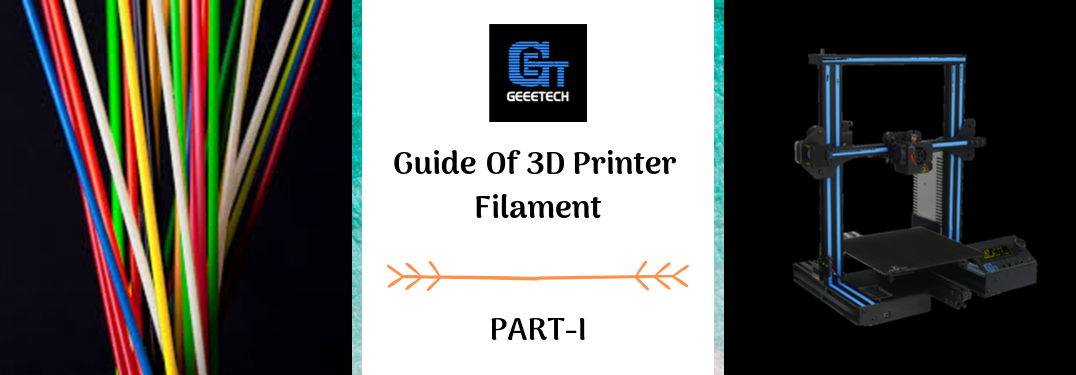Guide To 3D Printing Filaments PART-I
In this guide, you will come across various 3D printing filaments that will be explained in parts with in-depth knowledge about each of the filaments so that you can choose the best filament based on the necessity. In this part of the guide, you will learn about their importance, what they are made of, a list of filaments, and in detail about all the standard 3D printer filaments.
Importance of 3d printer filament
Hence, when it comes to a 3D printer, filament plays the main character as a thread in sewing the clothes. Therefore, filament acts as a thread along with 3D printers to build real-world objects. So it becomes very important to know what is it made of, what different types of filaments, what its cost, what are its benefits or applications, its advantages, and disadvantages, which is the best 3D printer filament, where to store a filament and, can filament be recycled let’s go on a tour of all these topics one by one in this guide.

Hence, you can now wisely choose which is the better filament for your 3D printer after understanding all the above-mentioned points related to the 3D printer filament so that you can enjoy printing what you want to print without any issues.
Do you know what is 3D filament made of?
3D filament acts as ink to the 3D printer so now let’s take a look at how it’s made. The filament is made up of plastic that undergoes 3 processes namely heating, extruding, and cooling plastic to form several nurdles. The filaments are usually made of thermoplastics that have different melting point properties when needed to print.

The diameter of the filament depends on the pull rather than the push through the nozzle after the plastic has been heated up. The diameter does not take the diameter of the extruder nozzle. And even the width is the same process as that of the diameter. Most all the filaments are 1.75 mm or 3mm in diameter.
The filaments come in a variety of colors and with different properties. But the plastic nurdles are always white and clear to produce various colors of filaments and with unique properties, several pigments or additives are added while melting the plastic.
List of 3D printer filaments
In this, I’m gone discuss the different types of 3D printer filaments. The filaments are differentiated into 5 types based on their properties. Namely standard, flexible, composite, specialty, and, support filament. When you get a 3D printer to home the first question that arises to mind is which filament to buy. so let’s discuss them one by one.

Standard Filament:
As the name standard filament, t is the most commonly used filament. All 3D printers are mainly capable of using these filaments which the 2 famous filaments are PLA and ABS filaments. Now let’s go through all the standard filaments.

PLA ( Polylactic Acid): It is one of the most commonly used filaments for most desktop 3D printers. And popular among Professionals and amateurs. It is also famous as an “Eco-friendly 3D printer filament” because it is made of organic renewable resources like cornstarch and sugarcane which do not produce pollution or contribute to global warming. Glow-in-dark colors and translucency are the special features/effects of this 3D printer material.
Advantages/Properties
- PLA doesn’t require a heating bed, doesn’t have a contagious smell, and due to its pleasant nature, many of them prefer it.
- On the other hand, it is easier and safer than any other printer.
- It is faster than any other printer with less wrap so it is best for beginners.
Disadvantages/issues
- ABS is stronger or solid than PLA
- The filament is more difficult to print when it comes in contact with moisture
- Inclined to clogging the printer nozzle.
Applications
- PLA filaments are mostly used in the field of Medicine for various surgical implants including pins, rods, screws, and mesh as they all break down in the human body.
- Also best used for cosmetic prints, prototypes, desk toys, and low-stress applications.
- Another few examples are where PLA is used in food packaging, disposable tableware, and diapers.
Price Starting from : $19.98 t0 $ 50 for 1.75mm/1kg spool
Link: http://bit.ly/3209ccE
Extrusion Temperature: Vary between 180 to 230 °C.

ABS(Acrylonitrile butadiene styrene): ABS is another most popular 3D printer material. Due to its high melting point, it becomes soft when melted so that it can take any shape and gets cooled quickly becoming more stiff, ductile, and tough to break.
Buy Now
Advantages/Properties
- Easy material to work due to it’s easy to extrude from the printer’s nozzle
- Most flexible, lightweight, stiff, ductile, durable, and strong nature makes it preferable than any other printer with wear resistance and heat tolerance.
- Nontoxic, water-resistance, and cheapest among all the 3D filaments.
- Post-processed with acetone to provide a glossy look.
Disadvantages/issues
- ABS is a non-renewable resource made of petroleum
- When heated up produces an unpleasant odor
- Requires high heated bed to print the material
- It requires ventilation because of its awful chemical odor.
- UV radiations break down ABS which loses its color and becomes brittle after long-term use in an outdoor environment
- ABS is not good for home users.
Applications
- ABS can be used in various fields such as automotive parts, moving parts, musical instruments, kitchen appliances, electronic housings, and various toys, like LEGO.
- ABS to make plastic wrap, water bottles, and cups are some other applications
Price Starting from $22.9 for a 1.75mm/1kg spool
Link: http://bit.ly/2nzudfh
Extrusion Temperature: Vary between 210 to 250 °C.
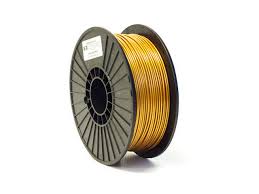
PRO Series PLA: The filament is the formulation of PLA for better and high-quality finished 3D printed products for professional use. These PLA are produced with more precise specifications and a tolerance of ± 0.05mm. It has all the similar properties of PLA.
Advantages/Properties
- A visually distinct finish and a more vibrant, opaque color than PLA filament.
- PLA doesn’t require a heating bed, doesn’t have a contagious smell, and due to its pleasant nature, many of them prefer it.
- On the other hand, it is easier and safer than any other printer.
- It is faster than any other printer with less wrap so it is best for beginners.
Disadvantages/issues
- ABS is stronger or solid than PLA
- The filament is more difficult to print when it comes in contact with moisture
- Inclined to clogging the printer nozzle.
Applications
- PLA filaments are mostly used in the field of Medicine for various surgical implants including pins, rods, screws, and mesh as they all break down in the human body.
- Also best used for cosmetic prints, prototypes, desk toys, and low-stress applications.
- Another few examples are where PLA is used in food packaging, disposable tableware, and diapers.
Price Starting from : $19.98 t0 $ 50 for 1.75mm/1kg spool
Link: http://bit.ly/33aF1Q6
Extrusion Temperature: Vary between 180 to 230 °C.

PRO Series ABS: The filament is the formulation of the ABS for the more beautiful, glossy, and, opaque finish with high-quality, precision 3D printed products. These ABS are produced with more precise specifications and a tolerance of ± 0.05mm. It has all the similar properties of ABS.
Advantages/Properties
- Easy material to work due to it’s easy to extrude from the printer’s nozzle
- The most flexible, lightweight, stiff, ductile, durable, and strong nature makes it preferable than any other printer with wear resistance and heat tolerance.
- Nontoxic, water-resistance, and cheapest among all the 3D filaments.
- Post-processed with acetone to provide a glossy look.
Disadvantages/issues
- ABS is a non-renewable resource made of petroleum
- Therefore, when heated up produces an unpleasant odor
- Requires high heated bed to print the material
- It requires ventilation because of its awful chemical odor.
- UV radiations break down ABS due which loses its color and becomes brittle after long-term use in an outdoor environment
- ABS is not good for home users.
Applications
- Hence, ABS can be used in various fields such as automotive parts, moving parts, musical instruments, kitchen appliances, electronic housings, and various toys, like LEGO.
- ABS to make plastic wrap, water bottles, and cups are some other applications
Price Starting from $22.9 for 1.75mm/1kg spool
Link: http://bit.ly/2nzudfh
Extrusion Temperature: Vary between 210 to 250 °C.

Tough PLA: The filament is stronger than the normal PLA with heat resistance up to 60°C. Therefore, ABS comes with its problems of overhangs, wrapping, and interlayer adhesion but this filament is slightly modified from the normal PLA and ABS which makes it the best for large printers. It still supports all the printers and also provides full geometric freedom while designing.
Advantages/Properties
- The tough and impact strength of its similar to ABS making it a much better filament for practical printing purposes.
- Ease of printing and reliable nature make it better for larger volume printing.
- Combining it with PVA is more beneficial and gives more complex curves, internal details, and harsh overhangs 3D print beautifully.
Disadvantages/issues
- The filament is more difficult to print when it comes in contact with moisture
- Inclined to clogging the printer nozzle.
Applications
- Used to produce strong plastic parts, large models, and complex geometries.
Price Starting from : $19.98 t0 $ 50 for 1.75mm/1kg spool
Link: http://bit.ly/33aF1Q6
Extrusion Temperature: Vary between 210 t0 230°C.
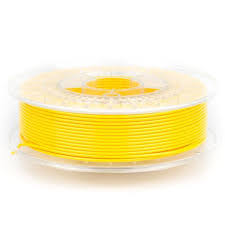
ColorFabb nGen: The filament doesn’t require to refine print settings again and again so you can print once you set up the printer for a long time without any disturbance so it is good for beginners. Gives a frosty and crisp look when printed with it.
Advantages/Properties
- Print materials with a wide range of temperatures and speeds you can spend more time printing rather than refining its settings.
- Due to its high heat resistance flows nicely into the nozzle and doesn’t clog often.
- Best printed on a heated bed and has less wrapping due to similar adhesion.
- Good interlayer adhesion and low odor while printing.
Disadvantages/issues
- More expensive than any other filament
- The brittle nature makes printed materials easily breakable.
- Hairy prints, pillowing, and filament seeping/oozing may occur during printing
Applications
- Best for printing durable parts avoiding print failure.
- Mind-boggling ability to print parts with many bridges successfully where other 3D printer materials have failed.
Price Starting from : $30.00 t0 $ 50 for 1.75mm/1kg spool
Extrusion Temperature: Vary between 220 to 240°C.
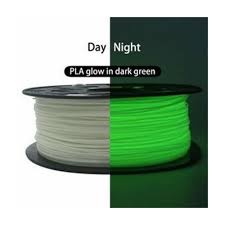
Glow-In-The-Dark: As the name says Glow-in-the-dark glows in the dark like a twinkling of stars at night in the sky. Therefore, it requires normal settings as that of PLA and ABS. The material printed out of it glows to the brightest when it is dark and emits all the vibrant colors in which it is printed. For more glow add more perimeters to your prints. These filaments are found in three categories of filament PLA, ABS, and TPU.
Advantages/Properties
- Properties are similar to normal PLA don’t require a heated bed, eco-friendly, easy to use, renewable, safe to use, and durable.
- During the cooling process has low shrinkage.
Disadvantages/issues
- Not safe for food products
- It is abrasive and has frayed out the nozzle for this you can install a hardened steel nozzle.
Applications
- Mainly used to produce children’s room decor products and ceiling stars.
- Used for light cover switches and novelty decoration products
- For Halloween themes, it is the best filament.
- Best friend for artistic people.
Price Starting from : $18.00 t0 $ 50 for 1.75mm/1kg spool
Extrusion Temperature: Vary between 180 to 240°C.
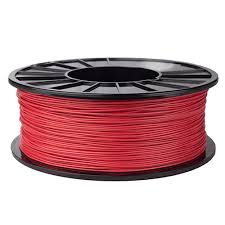
Nylon (polyamide): This is a synthetic polymer that especially has unique features compared to PLA and ABS, it is undoubtedly stronger, impact, durable, and versatile than the popular filaments. There are various kinds of nylon filaments explained below.
Advantages/Properties
- Flexible, strong, impact and durable
- 100% thermoplastic in nature
- Less brittle than ABS and PLA
- Products can be moved for sale after printing without sanding, polishing, scraping, or pesky acetone vapor baths.
- Easily colored/dyed
Disadvantages/issues
- Nylon should be preserved in a dry area free from moisture because it is very sensitive.
- At the start, the filament may wrap while printing.
- Printed parts are less precise due to shrinking while cooling
- Max lifetime of 12 months of nylon of various brands
Applications
- High interlayer adhesion makes it perfect for living hinges and other functionally strong parts.
- Also ready to print tough functional parts, wear parts, and production-ready prints.
- Hence, well-suited for various consumer products, tools, mechanical components, machine parts, structural parts, containers, and much more.
Price Starting from: $40.00 t0 $ 50 for 1.75mm/1kg spool
Extrusion Temperature: Vary between 210 t0 250°C.
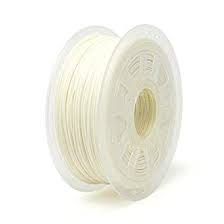
NylonX: Polyamide with chopped carbon strands this filament comes out with amazing properties which are better than the normal Nylon filament. In addition, its matte finish look provides the most elegant look and standardizes the richness of the products.
Advantages/Properties
- Nylon combined with micro-particles of carbon makes the filament stiffer, impact resistance, and high strength.
- As for stability and rigidity, the products are much more likely to wrap compared to ordinary nylon.
- Eliminates the post-print processing.
- Strong like carbon and durable like nylon.
- Products can be moved for sale after printing without sanding, polishing, scraping, or pesky acetone vapor baths.
- Easily colored/dyed
Disadvantages/issues
- NylonX should be preserved in a dry area free from moisture because it is very sensitive.
- At the start, the filament may wrap while printing.
- Printed parts are less precise due to shrinking while cooling
- Max lifetime of 12 months of nylon of various brands
Applications
- An engineering-graded filament that gives you the durability of nylon and stiffness of carbon is always ready for home products 3D printing and also ready to print tough functional parts, wear parts, and production-ready prints.
Price Starting from: $39.99 t0 $ 50 for 1.75mm/1kg spool
Extrusion Temperature: Vary between 210 t0 260°C.
I hope this guide to 3D printing filaments part I might help you to choose the filaments. This is not an end there are other parts coming up in the future.
